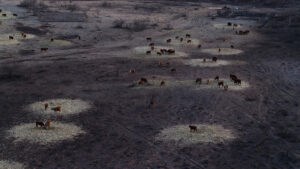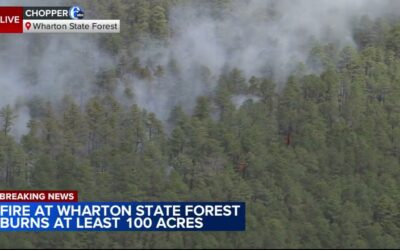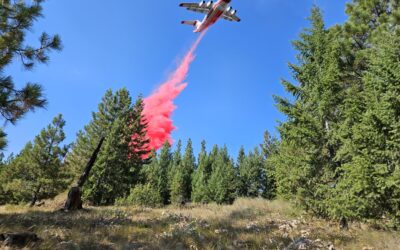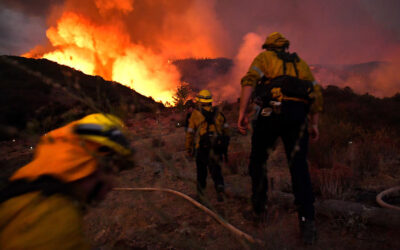
An aerial view shows cattle grazing on small islands of hay surrounded by pastureland burned by the Smokehouse Creek fire on Monday, March 4, 2024, near Canadian, Texas. The fire has burned more than a million acres in the Texas Panhandle, killing at least two people and destroying more than 500 structures. (Scott Olson/Getty Images/TNS)
Brian K Sullivan, Jessica Nix and David Stringer
Bloomberg News
(TNS)
After a year of deadly wildfires around the globe, the world is burning again from Texas to Australia — and in some regions, the blazes are igniting early.
Canada’s Alberta province said last month that wildfire season had already begun, well before the typical March start. On the other side of the planet, South Australia instituted outdoor fire bans in mid-October, weeks ahead of when it normally does.
While late-winter fires aren’t unusual in the Texas Panhandle, the current blaze is the worst in the state’s history. In the rest of Texas, where winter conflagrations are rare, the summer wildfire season is starting earlier and getting longer.
Behind the many culprits of forest and brush fires — from land management to downed power lines — is the shadow of climate change. Global warming is contributing to hot, dry conditions at times of the year that historically were rainier. That’s complicating government efforts to prevent the blazes and intensifying pressure on electric utilities to shore up their systems.
“Climate is connected to fire in many ways — most obviously through extreme weather conditions — but climate also influences ignitions, fuel, moisture and the growth of vegetation,” said Hamish Clarke, a senior research fellow at the University of Melbourne’s Flare Wildfire Research Group. “In many cases it’s going to make things much, much worse.”
The fire scorching homes and ranches across the Texas Panhandle started after a dry spell that lasted a few weeks, allowing the grass to dry out. On Feb. 26, high winds swept through the area as temperatures soared. Nearby Amarillo posted a record high of 82F (28C) for the date.
“Climate change certainly played a role in the amount of heat and dryness,” said John Nielsen-Gammon, Texas state climatologist and a professor at Texas A&M University.
Across Texas, the weather will stay sunny, dry and breezy through the rest of the week, said Frank Pereira, a senior branch forecaster at the U.S. Weather Prediction Center. While not enough to trigger a red flag fire warning, dry and windy conditions can make fire fighting more difficult.
Later in the week, there is a chance of showers that may help with the Smokehouse Creek fire and other blazes in the Texas Panhandle.
Across the Panhandle and the rest of the southern Great Plains, there are two fire seasons: One comes at the end of winter into early spring and the other during the summer months, said Todd Lindley, science and operations officer for the National Weather Service in Norman, Oklahoma.
“We are seeing an increase in our summer fire season,” Lindley said. “Summers have been trending hotter in the last couple of decades and that has had a corresponding increase in summer fire activity, especially in Texas and Oklahoma.”
This year, El Niño is amplifying the impact of a hotter climate. The weather pattern, a warming of the equatorial Pacific Ocean, usually brings rainier conditions to Texas and the rest of the U.S. South. But this year, unusually, some storms have tracked north through Colorado, leaving hot, arid air across the Southwest and supercharging winds, said Ryan Truchelut, president of commercial forecaster WeatherTiger LLC.
To the north in Canada, El Niño has worried forecasters for months because the phenomenon leads to more storms crossing the U.S. rather than further north, cutting off large swaths of western Canada from snow. At least 72% of the country was in drought this winter, according to the North American Drought Monitor.
A year ago, Canada’s wildfire season began early and morphed into its worst ever, blanketing the U.S. in smoke that turned the skies over New York City an apocalyptic orange.
Some of those blazes never went out. As of January, a record number of “zombie fires” remained burning in the ground and under snow, with about 100 fires in British Columbia, according to Premier David Eby.
“We’re literally standing up an army of firefighters in British Columbia,” Eby told reporters on Feb. 23, citing 1,000 applicants for the forest fire service, agreements to lease aircraft and helicopters and discussions with the military. “We’re just profoundly worried about the situation we face.”
Brett L’Esperance is chief executive officer of Dauntless Air, a private fleet of single-engine air tankers that fly across North America dumping water on wildfires. His crews went to Canada last year, but also fought fires in Louisiana and North Carolina, places that haven’t needed air tankers before.
Across the continent, “fire season is starting much earlier than it did before and it ends later,” he said.
Thousands of miles away in Australia, El Niño tends to dry out large swaths of land, leading to more fires. Three years of wetter conditions accelerated vegetation growth before a record 2023 arid spell increased the flammability of that fuel — raising risks through a bushfire season that typically peaks in southern areas between December and February.
Authorities in parts of Victoria state last month warned of the worst conditions since the so-called Black Summer fires of 2019 to 2020, which killed 33 people. Thousands of residents were evacuated last week near the regional city of Ballarat as blazes spread across at least 22,000 hectares (54,363 acres) of land and destroyed homes.
The fire threat is expected to linger through the southern hemisphere fall season, with heightened risks in parts of central and western Australia, according to AFAC, the national council for fire and emergency services.
“Obviously there are so many different actions we can take to prepare for and to mitigate bushfire risk, but to me it’s a real no-brainer: Let’s not put more heat into the system,” the University of Melbourne’s Clarke said. “We need to be taking strong climate change action.”
_____
(With assistance from Thomas Seal.)
_____
©2024 Bloomberg L.P. Visit bloomberg.com. Distributed by Tribune Content Agency, LLC.




